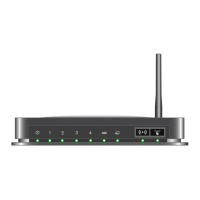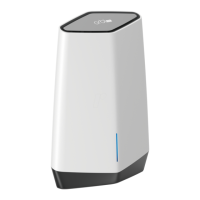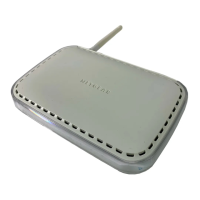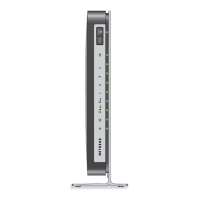Wireless-N 150 ADSL2+ Modem Router DGN1000 User Manual
Configuring Your Wireless Network and Security Settings 2-7
v1.1, January 2010
Manually Configuring Your Wireless Security
To set up wireless security, you can either manually configure it in the Wireless Settings screen, or
you can use Wi-Fi Protected Setup (WPS) to automatically set the SSID and implement
WPA/WPA2 security (see “Using Push 'N' Connect (WPS) to Configure Your Wireless Network
and Security” on page 2-13).
Wireless Station
Access List
Turn Access Control On Access control is disabled by default so that any computer
configured with the correct wireless network name or SSID
can access to your wireless network. For increased
security, you can restrict access to the wireless network to
only specific computers based on their MAC addresses.
See
“Restricting access by MAC address.”
Security Options • Disable. Wireless security is not used.
• WEP. In WEP (Wired Equivalent Privacy) mode you can select 64-bit or 128-bit data
encryption. This mode has been superseded by WPA-PSK and WPA2-PSK, which
should be selected if possible. See
“Configuring WEP.”
• WPA-PSK. WPA Pre-Shared-Key (Wi-Fi Protected Access Pre-Shared Key) uses a pre-
shared key to perform the authentication and generate the initial data encryption keys.
Then, it dynamically varies the encryption key. WPA-PSK uses TKIP (Temporal Key
Integrity Protocol) data encryption, implements most of the IEEE 802.11i standard, and
is designed to work with all wireless network interface cards, but not all wireless access
points.”
• WPA2-PSK. WPA Pre-Shared-Key (Wi-Fi Protected Access 2 with Pre-Shared Key)
uses a pre-shared key to perform the authentication and generate the initial data
encryption keys. Then, it dynamically varies the encryption key. WPA2-PSK provides
the best throughput with 802.11N because the encryption is supported in the hardware.
WPA2-PSK uses AES (Advanced Encryption Standard) data encryption, implements
the full IEEE 802.11i standard, but does not work with some older network cards.
• Mixed WPS-PSK+ WPA2-PSK. Uses both WPA-PSK + WPA2-PSK standard
encryption. A high performance client such as the NETGEAR WN511B should connect
using WPA2-PSK in order to achieve maximum performance. Wireless clients that
connect to this router using WPA-PSK will run at reduced performance levels. See
“Configuring Mixed WPA-PSK+WPA2-PSK Security.”
• WPA-802.1x. User authentication is implemented using 802.1x and RADIUS servers.
See
“Configuring WPA-802.1x.”
Table 2-1. Wireless Settings (continued)
Settings Description

